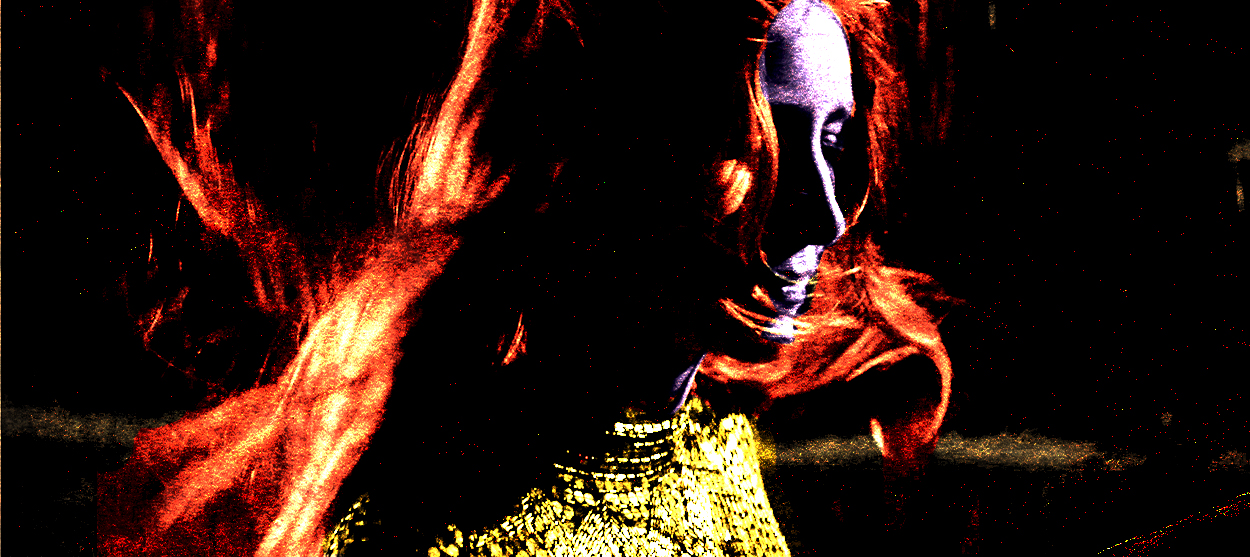Game of Thrones just got very, very dark
The show's underexposed shots are making viewers squint. But there's probably a strategic reason for that.


If you spent last night squinting at your screen and impotently trying to increase its brightness, you aren't alone. Game of Thrones has gone dark. Very, very dark. Here's a collection of scenes taken from various points in "Stormborn":

The episode was so poorly lit I had a genuinely difficult time figuring out what was happening at the most basic level during Euron's onslaught. You know how you're supposed to try to look at dim stars from the side, because that's where most of your eyes' light-sensitive rods are? I was side-eyeing as hard as I could to see his ship. And I did it! Here it is:
[[{"type":"media","view_mode":"media_large","fid":"198829","attributes":{"alt":"","class":"media-image","height":"337","typeof":"foaf:Image","width":"600"}}]](Screenshot/HBO/Game of Thrones)
The Week
Escape your echo chamber. Get the facts behind the news, plus analysis from multiple perspectives.

Sign up for The Week's Free Newsletters
From our morning news briefing to a weekly Good News Newsletter, get the best of The Week delivered directly to your inbox.
From our morning news briefing to a weekly Good News Newsletter, get the best of The Week delivered directly to your inbox.
Even so, I was more confused than awed when a larger black pole penetrated the sea of grey-black:
[[{"type":"media","view_mode":"media_large","fid":"198830","attributes":{"alt":"","class":"media-image","height":"337","typeof":"foaf:Image","width":"600"}}]] (Screenshot/HBO/Game of Thrones)
But perhaps that's unfair. Euron's was supposed to be a surprise attack, after all. It makes sense that he's near-invisible. Let's look at some other moments, like the dramatic reveal of the Weapon That Kills Dragons. See it there, silhouetted in the gloam?
[[{"type":"media","view_mode":"media_large","fid":"198831","attributes":{"alt":"","class":"media-image","height":"337","typeof":"foaf:Image","width":"600"}}]](Screenshot/HBO/Game of Thrones)
A free daily email with the biggest news stories of the day – and the best features from TheWeek.com
In this image, some black shadows in the foreground block our view of a dark-grey thing behind them that appears to be (side-eye, side-eye hard) ... yes, it's a mediocre statue of Ned Stark!). Aha! This must be Jon and Littlefinger.
[[{"type":"media","view_mode":"media_large","fid":"198832","attributes":{"alt":"","class":"media-image","height":"335","typeof":"foaf:Image","width":"600"}}]](Screenshot/HBO/Game of Thrones)
My point is this: If you weren't carefully watching what came before this image came onscreen, you'd have no idea what it depicted. This is clearly deliberate.
The question is: Why is it happening?
It's not exactly novel that Game of Thrones chronically underexposes. People have complained about it for years. Here's a sample article from last year listing some scenes that were too dark. But it's gotten worse. Reading that article, I sighed enviously looking at the selected screenshots. They might as well be in HDR compared to what the show has become. And I laughed out loud during the first few shots of "Stormborn" because I thought the show was joking about its own tendency to do this. Here's an early shot of Dragonstone:
[[{"type":"media","view_mode":"media_large","fid":"198819","attributes":{"alt":"","class":"media-image","height":"334","typeof":"foaf:Image","width":"600"}}]](Screenshot/HBO/Game of Thrones)
Glorious, isn't it?
To forestall the inevitable discussion of whether or not the above scenes are actually too dark to make out, I'm going to briefly offer a couple of images along with histograms. Just FYI, a histogram is a guide that measures tonal distribution in an image; it can help you determine whether a particular shot is underexposed. Here's a quick explainer using an extreme example:
[[{"type":"media","view_mode":"media_large","fid":"198821","attributes":{"alt":"","class":"media-image","height":"313","typeof":"foaf:Image","width":"600"}}]]
Okay. Now here's the histogram for the saucy scene between Yara and Ellaria Sand (which is one of the better-lit scenes in that whole last section):
[[{"type":"media","view_mode":"250px_wide","fid":"198823","attributes":{"alt":"","class":"media-image","height":"157","style":"display: block; margin-left: auto; margin-right: auto;","typeof":"foaf:Image","width":"250"}}]]
The image that came from:
[[{"type":"media","view_mode":"media_large","fid":"198824","attributes":{"alt":"","class":"media-image","height":"333","typeof":"foaf:Image","width":"600"}}]](Screenshot/HBO/Game of Thrones)
Compare that to the "extreme" example of underexposure above.
Let's take another example.
Here's Melisandre's first meeting with Daenerys:
[[{"type":"media","view_mode":"media_large","fid":"198850","attributes":{"alt":"","class":"media-image","height":"336","typeof":"foaf:Image","width":"600"}}]](Screenshot/HBO/Game of Thrones)
And here's its histogram:
[[{"type":"media","view_mode":"250px_wide","fid":"198849","attributes":{"alt":"","class":"media-image","height":"178","style":"display: block; margin-left: auto; margin-right: auto;","typeof":"foaf:Image","width":"250"}}]]
The bad lighting here is extreme. It's chronic. It's deliberate. And it makes it really, maddeningly hard to see.
Why is Game of Thrones doing this to us?
I'm going to suggest a couple of reasons why "Stormborn" in particular might be doing this (leaving aside my suspicions that the recent explosion in cameras that perform well in low light is provoking an epidemic of squinty shots).
The first is that underexposure makes you squint and look really, really hard at whatever it is you're trying to make out. That makes match-cuts like last week's soup-poop montage and this week's Greyscale-to-creamy-stew (or pie, or whatever that was) a lot more gross.
You remember:
[[{"type":"media","view_mode":"media_large","fid":"198835","attributes":{"alt":"","class":"media-image","height":"332","typeof":"foaf:Image","width":"600"}}]](Screenshot/HBO/Game of Thrones)
[[{"type":"media","view_mode":"media_large","fid":"198836","attributes":{"alt":"","class":"media-image","height":"328","typeof":"foaf:Image","width":"600"}}]](Screenshot/HBO/Game of Thrones)
[[{"type":"media","view_mode":"media_large","fid":"198837","attributes":{"alt":"","class":"media-image","height":"329","typeof":"foaf:Image","width":"600"}}]](Screenshot/HBO/Game of Thrones)
[[{"type":"media","view_mode":"media_large","fid":"198838","attributes":{"alt":"","class":"media-image","height":"328","typeof":"foaf:Image","width":"600"}}]](Screenshot/HBO/Game of Thrones)
[[{"type":"media","view_mode":"media_large","fid":"198839","attributes":{"alt":"","class":"media-image","height":"337","typeof":"foaf:Image","width":"600"}}]](Screenshot/HBO/Game of Thrones)
Yum.
But the other reason has to do with the prophecy. If the prince (or princess) who was promised will bring the dawn, you have to make it night first. If you want the viewer to long for deliverance the way the people of the Seven Kingdoms do, make that "darkest before dawn" thing literal. Dress virtually everyone in black, set almost every scene at night, throw in a storm, some fog, and the darkest fight sequence ever filmed.
There's some support for this theory: Several scenes in "Stormborn" begin with an establishing shot that has huge dark things obstructing it. Only after the camera slowly slides out from behind them is the focus of the scene revealed. This is annoying. It makes us want to bob to get out from behind the darkness. Here's our first shot of Jon Snow's speech to the lords in Winterfell. We start in the back of the room, with its lowliest members — which nicely emphasizes the point that this desire for dawn belongs to the people:
[[{"type":"media","view_mode":"media_large","fid":"198842","attributes":{"alt":"","class":"media-image","height":"335","typeof":"foaf:Image","width":"600"}}]](Screenshot/HBO/Game of Thrones)
Our first glimpse of Arya as she's being surrounded comes from behind a log that initially obscures a lot of the frame. Only in retrospect are we aware that this is a wolves'-eye view:
[[{"type":"media","view_mode":"media_large","fid":"198843","attributes":{"alt":"","class":"media-image","height":"339","typeof":"foaf:Image","width":"600"}}]](Screenshot/HBO/Game of Thrones)
Our first view of the Sand Snakes is obstructed by beams as we stare down at them from above:
[[{"type":"media","view_mode":"media_large","fid":"198844","attributes":{"alt":"","class":"media-image","height":"330","typeof":"foaf:Image","width":"600"}}]](Screenshot/HBO/Game of Thrones)
There are limits to this, of course. It's telling, for one thing, that the two people lit differently are Cersei and Arya. Cersei certainly doesn't share this desire for the new dawn, and neither, arguably, do the nobles she's addressing. Consequently, she's a little more normally lit. Same with Arya. Her chat with Hot Pie is in a typically dark interior, but the candle they're sitting in front of lights them reasonably well.
Then there's the dire wolf Arya thinks is Nymeria, whose appearance onscreen seems so bright by comparison, it's almost blinding:
[[{"type":"media","view_mode":"media_large","fid":"198852","attributes":{"alt":"","class":"media-image","height":"336","typeof":"foaf:Image","width":"600"}}]](Screenshot/HBO/Game of Thrones)
But here's the histogram of that shot. You'll notice it's still pretty underexposed! There's nothing in the right third!
[[{"type":"media","view_mode":"250px_wide","fid":"198853","attributes":{"alt":"","class":"media-image","height":"188","style":"display: block; margin-left: auto; margin-right: auto;","typeof":"foaf:Image","width":"250"}}]]
As experiments linking ethics to optics go, this is an interesting one. This was an episode about the Lord of Light: what he can offer, what he demands. Melisandre's appearance follows Varys' claim that he's an advocate for the common people. Whether any of this maps onto anything like salvation, or virtue, or good, is an open question — one literalized by the episode's use of light. Deprive folks of a true white for long enough and their eyes will embrace a version of it that's objectively gray.
Lili Loofbourow is the culture critic at TheWeek.com. She's also a special correspondent for the Los Angeles Review of Books and an editor for Beyond Criticism, a Bloomsbury Academic series dedicated to formally experimental criticism. Her writing has appeared in a variety of venues including The Guardian, Salon, The New York Times Magazine, The New Republic, and Slate.
-
 ‘Care fractures after birth’
‘Care fractures after birth’instant opinion Opinion, comment and editorials of the day
-
 Shots fired in the US-EU war over digital censorship
Shots fired in the US-EU war over digital censorshipIN THE SPOTLIGHT The Trump administration risks opening a dangerous new front in the battle of real-world consequences for online action
-
 What will the US economy look like in 2026?
What will the US economy look like in 2026?Today’s Big Question Wall Street is bullish, but uncertain
-
 Walter Isaacson's 'Elon Musk' can 'scarcely contain its subject'
Walter Isaacson's 'Elon Musk' can 'scarcely contain its subject'The latest biography on the elusive tech mogul is causing a stir among critics
-
 Welcome to the new TheWeek.com!
Welcome to the new TheWeek.com!The Explainer Please allow us to reintroduce ourselves
-
 The Oscars finale was a heartless disaster
The Oscars finale was a heartless disasterThe Explainer A calculated attempt at emotional manipulation goes very wrong
-
 Most awkward awards show ever?
Most awkward awards show ever?The Explainer The best, worst, and most shocking moments from a chaotic Golden Globes
-
 The possible silver lining to the Warner Bros. deal
The possible silver lining to the Warner Bros. dealThe Explainer Could what's terrible for theaters be good for creators?
-
 Jeffrey Wright is the new 'narrator voice'
Jeffrey Wright is the new 'narrator voice'The Explainer Move over, Sam Elliott and Morgan Freeman
-
 This week's literary events are the biggest award shows of 2020
This week's literary events are the biggest award shows of 2020feature So long, Oscar. Hello, Booker.
-
 What She Dies Tomorrow can teach us about our unshakable obsession with mortality
What She Dies Tomorrow can teach us about our unshakable obsession with mortalityThe Explainer This film isn't about the pandemic. But it can help viewers confront their fears about death.
